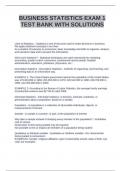BUSINESS STATISTICS EXAM 1
TEST BANK WITH SOLUTIONS
Uses of Statistics: - Statistics is one of the tools used to make decisions in business
We apply statistical concepts in our lives
As a student of business or economics, basic knowledge and skills to organize, analyze,
and transform data and to present the information.
Who Uses Statistics? - Statistical techniques are used extensively by marketing,
accounting, quality control, consumers, professional sports people, hospital
administrators, educators, politicians, physicians, etc...
Descriptive Statistics - Descriptive Statistics - methods of organizing, summarizing, and
presenting data in an informative way.
EXAMPLE 1: The United States government reports the population of the United States
was 179,323,000 in 1960; 203,302,000 in 1970; 226,542,000 in 1980; 248,709,000 in
1990, and 265,000,000 in 2000.
EXAMPLE 2: According to the Bureau of Labor Statistics, the average hourly earnings
of production workers was $17.90 for April 2008.
Inferential Statistics - Inferential Statistics: A decision, estimate, prediction, or
generalization about a population, based on a sample.
Population - A population is a collection of all possible individuals, objects, or
measurements of interest.
Sample - A sample is a portion, or part, of the population of interest
Why take a sample instead of studying every member of the population? - Prohibitive
cost of census
Destruction of item being studied may be required
Not possible to test or inspect all members of a population being studied
Qualitative or Attribute variable - Qualitative or Attribute variable - the characteristic
being studied is nonnumeric.
EXAMPLES: Gender, religious affiliation, type of automobile owned, state of birth, eye
color are examples.
, Quantitative variable - Quantitative variable - information is reported numerically.
EXAMPLES: balance in your checking account, minutes remaining in class, or number
of children in a family.
Discrete variables - Discrete variables: can only assume certain values and there are
usually "gaps" between values.
EXAMPLE: the number of bedrooms in a house, or the number of hammers sold at the
local Home Depot (1,2,3,...,etc).
Continuous variable - Continuous variable can assume any value within a specified
range.
EXAMPLE: The pressure in a tire, the weight of a pork chop, or the height of students in
a class.
Nominal level - Nominal level - data that is classified into categories and cannot be
arranged in any particular order.
EXAMPLES: eye color, gender, religious affiliation.
Interval level - Interval level - similar to the ordinal level, with the additional property that
meaningful amounts of differences between data values can be determined. There is no
natural zero point.
EXAMPLE: Temperature on the Fahrenheit scale. Interval scales are numerical scales
in which intervals have the same interpretation throughout. As an example, consider the
Fahrenheit scale of temperature. The difference between 30 degrees and 40 degrees
represents the same temperature difference as the difference between 80 degrees and
90 degrees. This is because each 10-degree interval has the same physical meaning (in
terms of the kinetic energy of molecules).
Ordinal level - Ordinal level - data arranged in some order, but the differences between
data values cannot be determined or are meaningless.
EXAMPLE: During a taste test of 4 soft drinks, Mellow Yellow was ranked number 1,
Sprite number 2, Seven-up number
Ratio level - Ratio level - the interval level with an inherent zero starting point.
Differences and ratios are meaningful for this level of measurement.
EXAMPLES: Monthly income of surgeons, or distance traveled by manufacturer's
representatives per month.
Another example of a ratio scale is the amount of money you have in your pocket right
now (25 cents, 55 cents, etc.). Money is measured on a ratio scale because, in addition
to having the properties of an interval scale, it has a true zero point: if you have zero
money, this implies the absence of money. Since money has a true zero point, it makes
sense to say that someone with 50 cents has twice as much money as someone with
25 cents
Nominal-Level Data Properties - Properties:
Observations of a qualitative variable can only be classified and counted.




